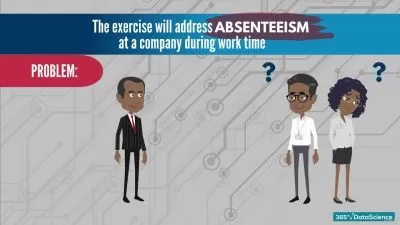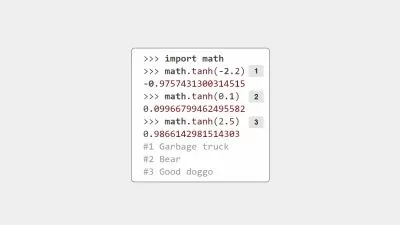01.01-introduction.mp4
01:54
01.02-course_overview.mp4
01:49
01.03-is_this_course_right_for_you.mp4
01:07
01.04-course_structure.mp4
01:08
01.05-neural_network_defined.mp4
02:56
01.06-framework_for_optional_learning.mp4
02:15
01.07-optimal_generalization_techniques.mp4
02:53
01.08-optimal_prediction_techniques.mp4
03:27
01.09-framework_application.mp4
02:56
01.10-diagnostic_learning_curves.mp4
02:56
01.11-the_fit_of_the_model.mp4
02:55
01.12-unrepresentative_dataset.mp4
01:49
02.01-neural_networks_learn_a_mapping_function.mp4
03:00
02.02-error_surface.mp4
02:02
02.03-features_of_the_error_surface.mp4
02:27
02.04-non-convex_error_surface.mp4
03:14
02.05-deep_learning_neural_network_components_part_1.mp4
03:25
02.06-deep_learning_neural_network_components_part_2.mp4
02:32
02.07-neural_network_model_capacity.mp4
01:50
02.08-anatomy_of_a_keras_model.mp4
06:10
02.09-demo_case_study_on_model_capacity_part_1.mp4
01:51
02.10-demo_case_study_on_model_capacity_part_2.mp4
03:31
02.11-demo_case_study_on_model_capacity_part_3.mp4
02:55
02.12-gradient_precision_with_batch_size.mp4
03:57
02.13-demo_case_study_on_batch_size_part_1.mp4
03:08
02.14-demo_case_study_on_batch_size_part_2.mp4
03:47
02.15-demo_case_study_on_batch_size_part_3.mp4
01:15
02.16-loss_function_defined.mp4
02:39
02.17-choosing_a_loss_function.mp4
01:44
02.18-demo_case_study_on_regression_loss_functions_part_1.mp4
02:22
02.19-demo_case_study_on_regression_loss_functions_part_2.mp4
04:42
02.20-demo_case_study_on_binary_classification_loss_functions_part_1.mp4
02:11
02.21-demo_case_study_on_binary_classification_loss_functions_part_2.mp4
01:50
02.22-demo_case_study_on_binary_classification_loss_functions_part_3.mp4
03:03
02.23-demo_case_study_on_multiclass_classification_loss_functions_part_1.mp4
02:31
02.24-demo_case_study_on_multiclass_classification_loss_functions_part_2.mp4
03:27
02.25-learning_rate_defined.mp4
02:57
02.26-configuring_the_learning_rate.mp4
02:08
02.27-learning_rate_schedules_and_adaptive_learning_rates.mp4
02:18
02.28-defining_learning_rates_in_keras.mp4
02:49
02.29-demo_case_study_on_learning_rates_part_1.mp4
02:35
02.30-demo_case_study_on_learning_rates_part_2.mp4
04:15
02.31-demo_case_study_on_learning_rates_part_3.mp4
04:04
02.32-demo_case_study_on_learning_rates_part_4.mp4
02:12
02.33-data_scaling.mp4
01:45
02.34-scaling_the_input_and_output_variables.mp4
01:34
02.35-normalize_and_standardize_(rescaling).mp4
01:43
02.36-demo_case_study_on_data_scaling_part_1.mp4
01:34
02.37-demo_case_study_on_data_scaling_part_2.mp4
01:58
02.38-demo_case_study_on_data_scaling_part_3.mp4
01:49
02.39-demo_case_study_on_data_scaling_part_4.mp4
03:18
02.40-activation_functions_and_vanishing_gradients.mp4
02:49
02.41-rectified_linear_activation_function_defined_and_implemented_in_python.mp4
02:51
02.42-when_relu_is_the_appropriate_choice.mp4
01:07
02.43-demo_case_study_on_vanishing_gradients_part_1.mp4
03:08
02.44-demo_case_study_on_vanishing_gradients_part_2.mp4
02:31
02.45-correct_exploding_gradients_with_clipping.mp4
03:42
02.46-gradient_clipping_in_keras.mp4
01:24
02.47-demo_case_study_on_exploding_gradients_part_1.mp4
02:19
02.48-demo_case_study_on_exploding_gradients_part_2.mp4
01:48
02.49-batch_normalization.mp4
02:22
02.50-tips_for_applying_batch_normalization.mp4
01:59
02.51-demo_case_study_on_batch_normalization_part_1.mp4
02:40
02.52-demo_case_study_on_batch_normalization_part_2.mp4
02:43
02.53-demo_greedy_layer-wise_pretraining_case_study_part_1.mp4
03:34
02.54-demo_greedy_layer-wise_pretraining_case_study_part_2.mp4
04:06
03.01-the_problem_of_overfitting.mp4
02:44
03.02-reduce_overfitting_by_constraining_complexity.mp4
01:57
03.03-regularization_approaches_for_neural_networks.mp4
02:35
03.04-penalize_large_weights_via_regularization.mp4
02:05
03.05-how_to_penalize_large_weights.mp4
01:58
03.06-tips_for_using_weight_regularization.mp4
02:14
03.07-demo_weight_regularization_case_study_part_1.mp4
01:32
03.08-demo_weight_regularization_case_study_part_2.mp4
04:01
03.09-activity_regularization.mp4
02:11
03.10-encouraging_smaller_activations.mp4
02:48
03.11-tips_for_activity_regularization.mp4
02:48
03.12-activity_regularization_in_keras.mp4
02:35
03.13-demo_activity_regularization_case_study.mp4
03:19
03.14-forcing_small_weights.mp4
02:45
03.15-how_to_use_a_weight_constraint.mp4
01:19
03.16-tips_for_applying_weight_constraints.mp4
01:30
03.17-weight_constraints_in_keras.mp4
01:42
03.18-demo_weight_constraint_case_study.mp4
02:56
03.19-dropout.mp4
02:02
03.20-dropout_mechanics.mp4
01:27
03.21-dropout_tips.mp4
02:21
03.22-dropout_in_keras.mp4
02:53
03.23-demo_dropout_case_study.mp4
02:43
03.24-noise_regularization.mp4
02:46
03.25-how_to_add_noise.mp4
02:59
03.26-noise_tips.mp4
01:46
03.27-adding_noise_in_keras.mp4
02:07
03.28-demo_noise_regularization_case_study.mp4
03:18
04.01-ensemble_learning.mp4
02:12
04.02-ensemble_neural_network_models.mp4
01:06
04.03-varying_the_major_elements.mp4
04:44
04.04-model_averaging_ensembles.mp4
01:45
04.05-ensembles_in_keras.mp4
02:23
04.06-demo_model_averaging_ensemble_case_study_part_1.mp4
02:45
04.07-demo_model_averaging_ensemble_case_study_part_2.mp4
02:13
04.08-demo_model_averaging_ensemble_case_study_part_3.mp4
03:12
04.09-weighted_average_ensembles.mp4
02:49
04.10-demo_weighted_average_ensemble_case_study_part_1.mp4
02:42
04.11-demo_weighted_average_ensemble_case_study_part_2.mp4
02:59
04.12-demo_weighted_average_ensemble_case_study_part_3.mp4
03:40
04.13-demo_weighted_average_ensemble_case_study_part_4.mp4
02:22
04.14-resampling_ensembles.mp4
03:57
04.15-demo_resampling_ensemble_case_study_part_1.mp4
02:31
04.16-demo_resampling_ensemble_case_study_part_2.mp4
04:13
04.17-demo_resampling_ensemble_case_study_part_3.mp4
02:50
04.18-demo_resampling_ensemble_case_study_part_4.mp4
02:52
04.19-horizontal_voting_ensembles.mp4
02:17
04.20-demo_horizontal_ensemble_case_study_part_1.mp4
01:35
04.21-demo_horizontal_ensemble_case_study_part_2.mp4
03:41
9781803243894_Code.zip















